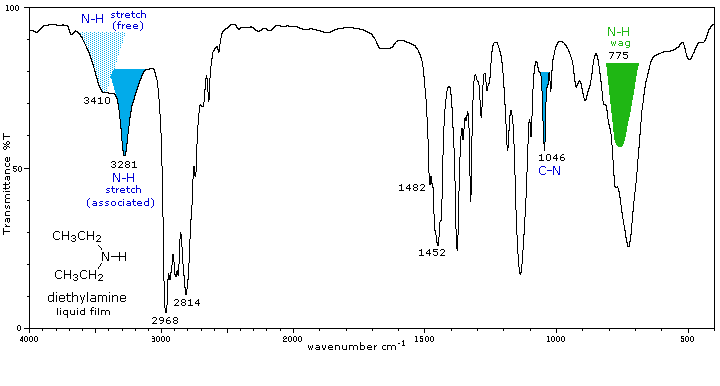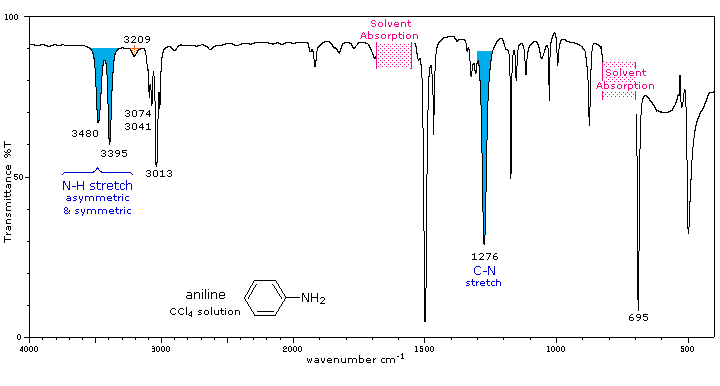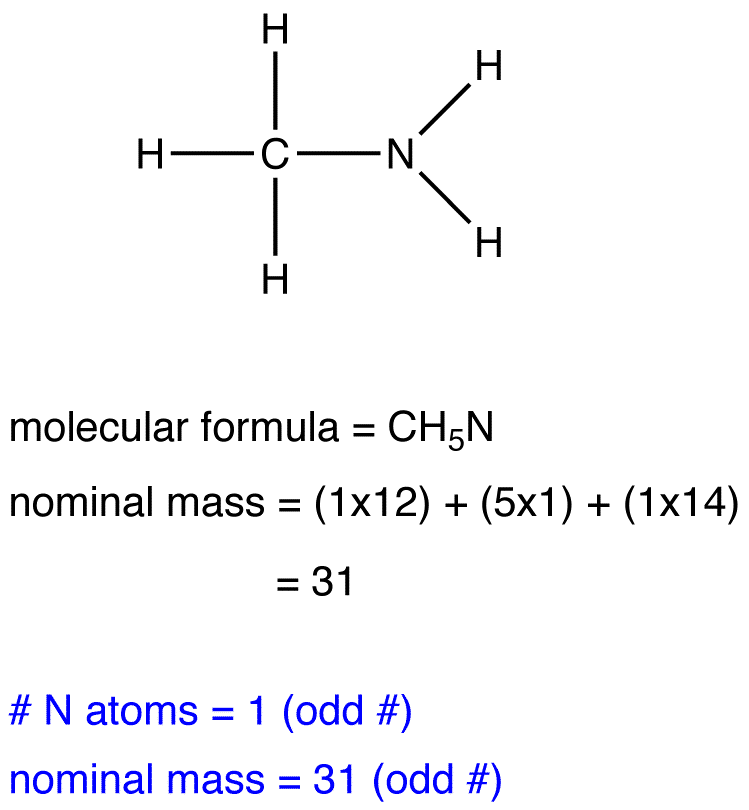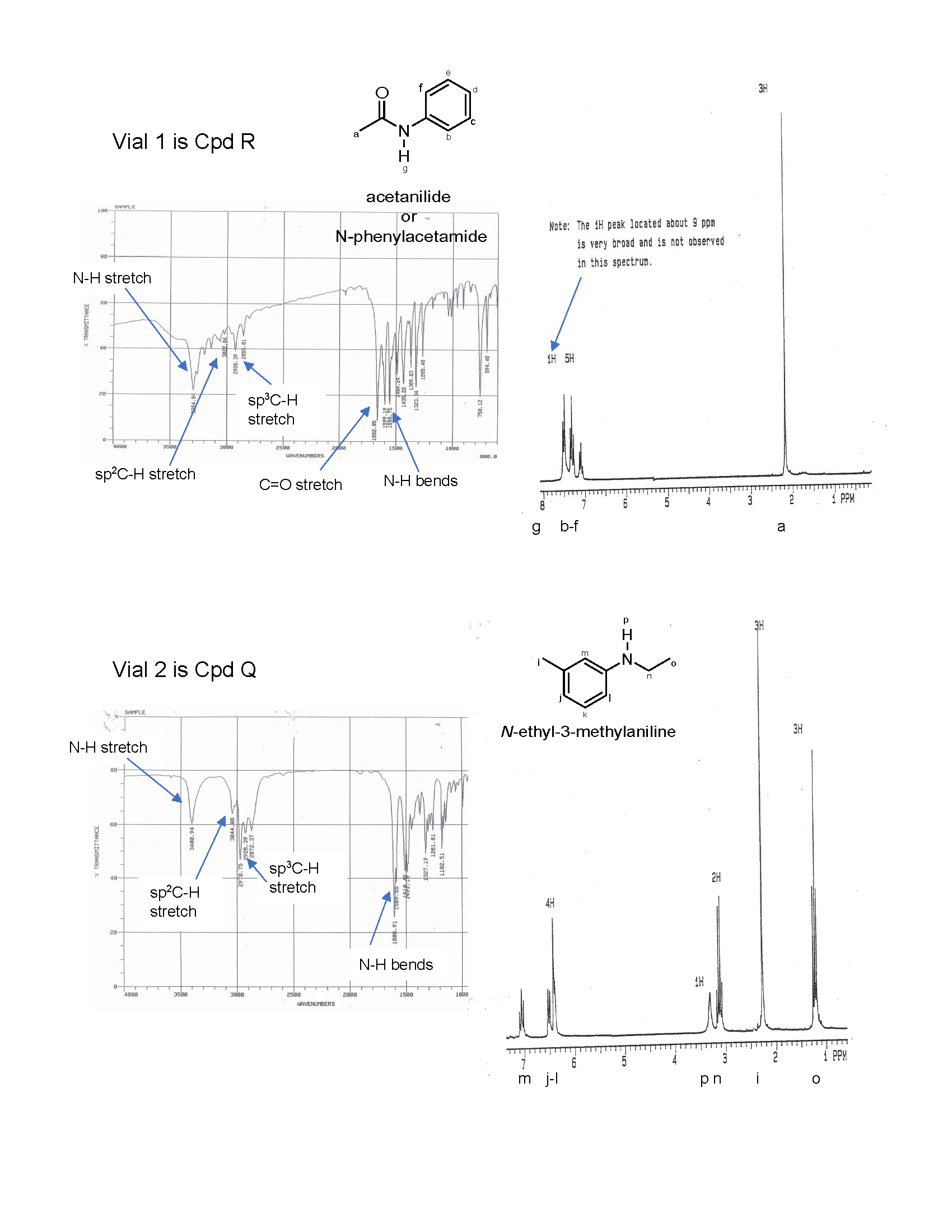20.3: Spectroscopy of Amines
- Page ID
- 45609
NMR
The hydrogens attached to an amine show up ~ 0.5-5.0 ppm. The location is dependent on the amount of hydrogen bonding and the sample's concentration.
The hydrogens on carbons directly bonded to an amine typically appear ~2.3-3.0 ppm.
Addition of D2O will normally cause all hydrogens on non-carbon atoms to exchange with deuteriums, thus making these resonances "disappear." Addition of a few drops of D2O causing a signal to vanish can help confirm the presence of -NH.
IR
The infrared spectrum of aniline is shown beneath the following table. Some of the characteristic absorptions for C-H stretching and aromatic ring substitution are also marked, but not colored.
|
Amine Class |
Stretching Vibrations |
Bending Vibrations |
|
|---|---|---|---|
|
Primary (1°) |
The N-H stretching absorption is less sensitive to hydrogen bonding than are O-H absorptions. In the gas phase and in dilute CCl4 solution free N-H absorption is observed in the 3400 to 3500 cm-1 region. Primary aliphatic amines display two well-defined peaks due to asymmetric (higher frequency) and symmetric N-H stretching, separated by 80 to 100 cm-1. In aromatic amines these absorptions are usually 40 to 70 cm-1 higher in frequency. A smaller absorption near 3200 cm-1 (shaded orange in the spectra) is considered to be the result of interaction between an overtone of the 1600 cm-1 band with the symmetric N-H stretching band. |
Strong in-plane NH2 scissoring absorptions at 1550 to 1650 cm-1, and out-of-plane wagging at 650 to 900 cm-1 (usually broad) are characteristic of 1°-amines. |
|
|
Secondary (2°) |
Secondary amines exhibit only one absorption near 3420 cm-1. Hydrogen bonding in concentrated liquids shifts these absorptions to lower frequencies by about 100 cm-1. Again, this absorption appears at slightly higher frequency when the nitrogen atom is bonded to an aromatic ring. |
A weak N-H bending absorption is sometimes visible at 1500 to 1600 cm-1. A broad wagging absorption at 650 to 900 cm-1 may be discerned in liquid film samples. |
|
|
Tertiary (3°) |
No N-H absorptions. The C-N absorptions are found in the same range, 1200 to 1350 cm-1 (aromatic) and 1000 to 1250 cm-1 (aliphatic) as for 1°-amines. |
Aside from the C-N stretch noted on the left, these compounds have spectra characteristic of their alkyl and aryl substituents. |



Mass Spectrometry and the Nitrogen Rule
The nitrogen rule states that a molecule that has no or even number of nitrogen atoms has an even nominal mass, whereas a molecule that has an odd number of nitrogen atoms has an odd nominal mass.
eg. 1:

eg. 2:

eg. 3:

Exercise
7. Oh no! The labels have fallen off two samples: Q and R. The elemental analysis for the samples indicated the following composition: compound Q is 81.15% C, 8.34% H, and 10.52% O and compound R is 71.08% C, 6.72% H, 10.36% N, and 11.84% O. Fortunately, we can analyze the samples using IR and 1H NMR spectroscopy. Name and draw the bond-line structures for compounds Q and R using the information provided. Support your answer by correlating the spectral data to the compound structures.

Contributors and Attributions
Dr. Dietmar Kennepohl FCIC (Professor of Chemistry, Athabasca University)
Prof. Steven Farmer (Sonoma State University)
William Reusch, Professor Emeritus (Michigan State U.), Virtual Textbook of Organic Chemistry
- Gamini Gunawardena from the OChemPal site (Utah Valley University)


